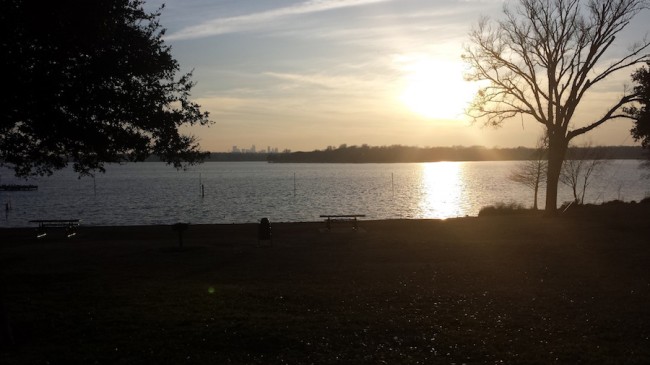It’s 1945, another hot summer in Dallas. Denne Freeman is an 11 year-old-boy with a group of friends and an adventurous dog. He lives on Tarleton Street, a half mile uphill from the shores of the White Rock Lake.
The lake is his playground. He hunts and fishes there, explores the woods, and swims.
“We had the big old White Rock Lake down there,” said Freeman, now 78 and who lives in Waco.
The manmade White Rock Lake was completed in 1911, bordered by Garland Road, Lawther Drive, East Mockingbird Lane and Buckner Boulevard. Except for people like Freeman, it wasn’t much of an attraction.
“That was before it was civilized,” Freeman said.
The lake became a central gathering palace for Dallasities in 1930, when the Bath House, the first Art Deco-styled building in the South, opened its doors. After, that, the visitors came and along with them vendors, multiple slides in the lake a pier for boats and imported sand.
The lake was “quite an attraction,” Freeman said, a former AP sports editor. “It was before cellphones. Before television.”
Freeman’s parents built their $2,800 home on a $385 lot. There were only a couple of homes overlooked the lake. Oilman H.L. Hunt’s Mount Vernon ,perched on a ten acre plot on the west side of the lake, faced oilman Everette Degoyler’s Spanish style estate, located on the southeast side. People from the various Dallas neighborhoods would flock to the shore in front of the Bath House, located on East Lawther Drive.
“You would go the Bath House and you would change into your swimsuits,” former SMU professor Darwin Payne said. “You would put your clothes in a basket and get a number. It’s one of those sort of things that don’t happen anymore.”
Before the land surrounding lake was officially sanctioned as a city park on in 1929, there was question as to what would happen to the land. According to the White Rock Lake exhibit at the Bath House, whether the shore would be come the new Coney Island or a recreational ground with croquet and golf fields was a question that plagued city council for two years. The city decided to allocate $30,000 for the park development including a sand beach and the Bath House.
“When it was brutally hot, that was the place to be,” Freeman said. “A lot of towns had Main Streets. That was our Main Street.”
Regardless of the fence that went up when the Bath House was built and a nine-cent fee, people still came to the lake in droves. They would carry nickels and dimes in their swimming suits and as they went down the large metal slides into the water, their coins would fall out of their pockets.
“Sometimes, you could find enough money to pay your way back in the next day,” Freeman said. “Sometimes you snuck around.”
Families would picnic on the shore, kids would buy soda from the Bath House, rebellious pre-teens would swim past the rope and teens would drive up there with in their cars for dates.
“There used to be an old saying that when you had a date you would take her to watch the submarines races,” Doris Heine wrote in a commemorative booklet Memories: 1930-1984. “It was another way of putting it that you would go out there and neck.”
By the time Freeman was a sophomore in high school, he had found new interests. He discovered girls, sports and cars.
“The lake wasn’t a thing to do any more,” he said.
Swimming was banned in 1953 because the city needed to repurpose the swimming hole into a water supply.
According to former SMU professor Payne, the city of Dallas was having trouble with a water shortage, Payne said. The total rainfall for 1952 was one percent of the normal rainfall and Lake Dallas, current Lake Lewisville, was at 11 percent of its capacity.
“There was a terrible drought in this area,” Payne said. “They started using it as a water supply and then they shut it down.”
Payne used to take his boys down to the lake. He fashioned his bicycle so that he could put one of his sons in the front of the bike in a basket and his other son ion the back.
“It was sort of fun to be there,” Payne said. “It was a family atmosphere.”
He still visits the lake once a day, but on the north side. He brings his 7-month-old Mini Australian Sheppard to the dog park. Payne’s bike hangs in his garage and his children still have roots in White Rock Lake.
“I still feel a tiny bit of excitement when I go to the lake,” Payne said.
There isn’t a gate anymore and joggers pass over where Dallasites used to sun bath. The Bath House is now a cultural center. Where showers used be, local art is now being hung.
One of the last times Freeman visited the shores of the lake, it was with his mother Maxine right before she died. When she was little, her father and her would go duck hunting, pick pecans and play baseball at the lake.
“It was pretty out here,” Maxine Freeman wrote in Memories: 1930-1984. “It was just country then.”
“Everything has changed so much,” Deene Freeman said. “I kinda wish it was the way it used to be. It’s still a beautiful place. Dallas is blessed.”










